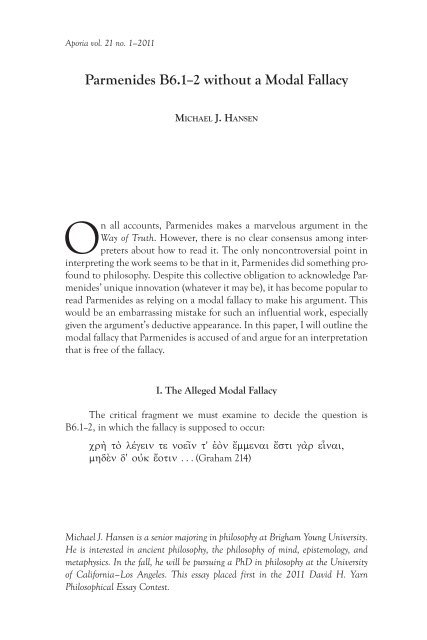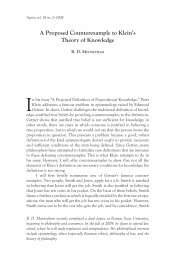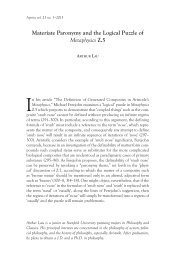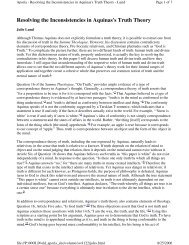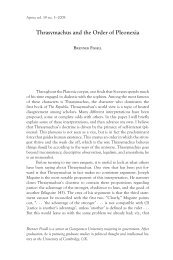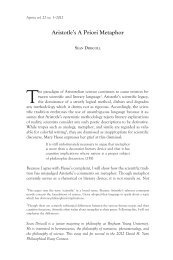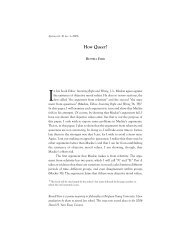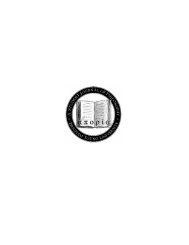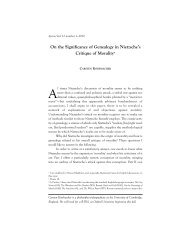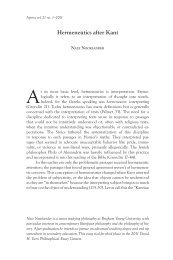Parmenides B6.1â2 without a Modal Fallacy - Aporia - Brigham ...
Parmenides B6.1â2 without a Modal Fallacy - Aporia - Brigham ...
Parmenides B6.1â2 without a Modal Fallacy - Aporia - Brigham ...
You also want an ePaper? Increase the reach of your titles
YUMPU automatically turns print PDFs into web optimized ePapers that Google loves.
<strong>Aporia</strong> vol. 21 no. 1—2011<br />
<strong>Parmenides</strong> B6.1–2 <strong>without</strong> a <strong>Modal</strong> <strong>Fallacy</strong><br />
Michael J. Hansen<br />
On all accounts, <strong>Parmenides</strong> makes a marvelous argument in the<br />
Way of Truth. However, there is no clear consensus among interpreters<br />
about how to read it. The only noncontroversial point in<br />
interpreting the work seems to be that in it, <strong>Parmenides</strong> did something profound<br />
to philosophy. Despite this collective obligation to acknowledge <strong>Parmenides</strong>’<br />
unique innovation (whatever it may be), it has become popular to<br />
read <strong>Parmenides</strong> as relying on a modal fallacy to make his argument. This<br />
would be an embarrassing mistake for such an influential work, especially<br />
given the argument’s deductive appearance. In this paper, I will outline the<br />
modal fallacy that <strong>Parmenides</strong> is accused of and argue for an interpretation<br />
that is free of the fallacy.<br />
I. The Alleged <strong>Modal</strong> <strong>Fallacy</strong><br />
The critical fragment we must examine to decide the question is<br />
B6.1–2, in which the fallacy is supposed to occur:<br />
crhV toV levgein te noei`n t' ejoVn e!mmenai e!sti gaVr ei^nai,<br />
mhdeVn d' oujk e!otin . . . (Graham 214)<br />
Michael J. Hansen is a senior majoring in philosophy at <strong>Brigham</strong> Young University.<br />
He is interested in ancient philosophy, the philosophy of mind, epistemology, and<br />
metaphysics. In the fall, he will be pursuing a PhD in philosophy at the University<br />
of California–Los Angeles. This essay placed first in the 2011 David H. Yarn<br />
Philosophical Essay Contest.
2<br />
Michael J. Hansen<br />
As usual, <strong>Parmenides</strong>’ language admits of many permissible translations for<br />
interpreters to quibble over, but this fragment is exceptionally difficult to<br />
render. T. M. Robinson rightly points out that “the fragment is notoriously<br />
replete with ambiguities” (627). Let us examine a few translations, then,<br />
keeping in mind that classicists and linguists can marshal complex arguments<br />
for and against each of them.<br />
In Early Greek Philosophy, John Burnet translates the fragment in<br />
this way:<br />
It needs must be that what can be spoken and<br />
thought is; for it is possible for it to be, and it is not<br />
possible for what is nothing to be. (174)<br />
In their commentary, Presocratic Philosophers, G. S. Kirk and J. E. Raven<br />
follow Burnet and offer a similar translation:<br />
That which can be spoken and thought needs must<br />
be; for it is possible for it, but not for nothing, to<br />
be. 1 (270)<br />
When these commentaries were published (in 1892 and 1957, respectively),<br />
they were considered authoritative and widely influenced Presocratic scholarship.<br />
Although these translators did not explicitly accuse <strong>Parmenides</strong> of a<br />
modal fallacy, one can detect it after formalizing their translations.<br />
To show the fallacy, I will convert the key phrases from the fragment<br />
into logical premises (note that the first premise comes from a previous<br />
fragment (B5)):<br />
“the same thing exists for thinking and for being”<br />
(Kirk and Raven 269).<br />
(1) x can be spoken/thought 2 ↔ x can exist. 3<br />
“it is possible for it [what can be thought and spoken<br />
of] to be”<br />
(2) What can be spoken/thought can possibly exist.<br />
1<br />
It is significant that when Schofield edited a second edition of Kirk and Raven’s collection, he<br />
gave a new translation that avoids the fallacy altogether by leaving out the modal qualifiers: “What<br />
is there to be said and thought must needs be: for it is there for being, but nothing is not” (247).<br />
2<br />
It is somewhat controversial what <strong>Parmenides</strong> has in mind here. Some consider it an unassuming<br />
reference to thinking and speaking, while others consider it more like simple ascertainment. We<br />
will see below how Robinson uses ascertainment to help avoid the fallacy.<br />
3<br />
It is very controversial how to construe “is there.” Whether <strong>Parmenides</strong> intended it to be a verb<br />
of existence, predication, identity, veridicality, fusion, or speculation is hotly contested. In this<br />
paper, I have construed it existentially, but it may be productive to examine how each sense bears<br />
on the fallacy. Mourelatos, in The Route of <strong>Parmenides</strong>, has argued that a speculative sense will avoid<br />
the fallacy (60–63).
<strong>Parmenides</strong> B6.1–2 <strong>without</strong> a <strong>Modal</strong> <strong>Fallacy</strong> 3<br />
“it is not possible for what is nothing to be”<br />
(3) What-is-not can’t possibly exist.<br />
“what can be spoken and thought is”<br />
∴ (C1) What can be spoken/thought exists. (2, 1 modus<br />
ponens)<br />
∴ (C2) Thus, what-is-not can’t be spoken/thought.<br />
(3, 1 modus tollens)<br />
The alleged fallacy is to take premise (3) as a de re statement (i.e., P → □P),<br />
when it can be read only as a de dicto statement (i.e., □(P → P)). That whatis-not<br />
is not is a simple de dicto truth—true in the same way that “all bachelors<br />
are unmarried men” is true. But the argument requires something<br />
stronger to effect its conclusion. The scope of this modal operator (whether<br />
it is a de re or a de dicto statement) means the difference between logical<br />
tautology and metaphysical necessity.<br />
If this is a correct translation and interpretation of B6.1–2, <strong>Parmenides</strong><br />
has certainly made a philosophical mistake. There are many conceptions<br />
of possibility (e.g., logical possibility and nomological possibility),<br />
and the Greek language remained ambiguous even between modal and<br />
moral operators. 4 But we will need to consider only the broadest meaning<br />
of the terms “possible” and “necessary” to discover the fallacy. There are<br />
many things that are possible: it is possible that the earth has two moons<br />
or that I ate spaghetti for dinner last night. Clearly, that these things are<br />
possible does not imply that they are also actual. That something can be<br />
does not imply that it obtains, at least not <strong>without</strong> additional argument.<br />
However, if we read <strong>Parmenides</strong> as making this mistake, his argument follows<br />
smoothly except for its reliance on this fallacious premise. 5<br />
The pieces needed to construct the fallacy have been agreed upon<br />
since Burnet and were reiterated by Kirk and Raven, but the fallacy took<br />
some time to gain attention. G. E. L. Owen was the first to explicitly accuse<br />
<strong>Parmenides</strong> of this modal fallacy, which he did in his watershed article “Eleatic<br />
Questions.” Here, Owen follows Burnet’s translation of B6.1–2 with<br />
some small stylistic differences:<br />
What can be spoken and thought of must exist; for<br />
it can exist, whereas nothing cannot. (94)<br />
This translation carries the same logical troubles for <strong>Parmenides</strong>’ argument<br />
that Burnet’s did. Owen describes <strong>Parmenides</strong>’ fallacy in a footnote:<br />
4<br />
See Kahn 722 and Robinson 633. e!sti can refer both to what is real and what is true.<br />
5<br />
This will become more clear when I treat Lewis’s interpretation below.
4<br />
Michael J. Hansen<br />
A, which can exist, is distinguished from B, which (poor<br />
thing) cannot: invalid, for to say ‘nothing cannot exist’<br />
is not to ascribe compulsory non-existence to anything<br />
but to say that it is necessarily (truistically) true that what<br />
doesn’t exist doesn’t exist, and this unexciting reformulation<br />
disables the argument. The fallacy is the so-called de<br />
re interpretation of modal statements. (94)<br />
Owen’s criticism is identical to the criticism of premise (3) given above: B<br />
cannot exist, but only in a de dicto formulation, not in a de re formulation,<br />
and for <strong>Parmenides</strong> to rule it out as an object of thought or speech requires<br />
the illegal de re statement.<br />
Owen gives two reasons to believe that “this celebrated fallacy is the<br />
point of the lines [B6.1–2]” (94). First, Owen believes this is the only translation<br />
that saves <strong>Parmenides</strong> from tautology, and the goddess clearly expects<br />
something more substantial than a tautology due to her injunction in<br />
B6.5, “that is what I bid you consider,” and due to her allusions to the first,<br />
wrong path in B2 (Kirk and Raven 270). Second, this translation fits nicely<br />
with the point of B3 (which establishes premise (1) above).<br />
Many scholars have followed Owen in ascribing this modal fallacy to<br />
<strong>Parmenides</strong>. 6 For example, Frank A. Lewis further presses the fallacy in his<br />
article, “<strong>Parmenides</strong>’ <strong>Modal</strong> <strong>Fallacy</strong>.” Lewis points out that in the poem, it<br />
appears that <strong>Parmenides</strong> presents some ways of inquiry and then argues by<br />
elimination for one of them: the way of is remains, while the ways of is not<br />
and of mixed (is and is not) fail. It is often supposed that mixed fails because<br />
of the law of excluded middle: if either is or is not, then the conjunct of the<br />
two (mixed) will be false. However, Lewis points out that this common reading<br />
of <strong>Parmenides</strong> fails to preserve this argumentative structure of elimination;<br />
<strong>Parmenides</strong>’ modal upgrades to is and is not (added in B2.3–6) make<br />
it impossible to eliminate mixed because of the law of excluded middle: “If<br />
the two ways are represented by their modalized upgrades, the disjunction<br />
of the two no longer makes an instance of the law of excluded middle” (2).<br />
The contingent, modal statements “is but can not be; and is not, but can be”<br />
are both still available, further ruining <strong>Parmenides</strong>’ argument by elimination<br />
(Lewis 2–3).<br />
Hence, instead of relying on the law of excluded middle to eliminate<br />
mixed, Lewis believes <strong>Parmenides</strong>’ denial of mixed relies on a modal fallacy<br />
that he calls an “illicit modal shift”: “‘necessarily (is → is)’ becomes<br />
‘is → necessarily is’” (5). This complaint is identical to the fallacy outlined<br />
6<br />
For example, in Philosophy Before Socrates, R. McKirahan quotes Owen on the modal fallacy and<br />
adds, “I assume that <strong>Parmenides</strong> was unaware of the fallacy” (164). However, McKirahan mistakenly<br />
cites Owen to substantiate his own claim that the argument “contains a subtle fallacy, treating<br />
‘nothing’ as if it could intelligibly, even if falsely, be said to exist” (164).
<strong>Parmenides</strong> B6.1–2 <strong>without</strong> a <strong>Modal</strong> <strong>Fallacy</strong> 5<br />
in premise (3) above. Furthermore, <strong>Parmenides</strong> could deny the contingent<br />
modal statements of mixed using this illicit modal shift. Hence, Lewis is<br />
confident that the argument by elimination can be restored by simply supposing<br />
that <strong>Parmenides</strong> was unaware of this fallacious modal shift, and the<br />
rest appears cogent enough.<br />
II. Possible Escapes from the <strong>Fallacy</strong><br />
Owen and Lewis offer a tidy reading of <strong>Parmenides</strong>’ poem, but assuming<br />
a fallacy is a high price to pay, especially for interpreting an exceptionally<br />
deductive argument like <strong>Parmenides</strong>’. If one is reading charitably,<br />
one ought to avoid readings that require such ugly fallacies from the outset.<br />
Not all scholars attribute the fallacy to <strong>Parmenides</strong>. Still, it may be challenging<br />
to find a translation that is free of the fallacy and that can compete<br />
with the otherwise graceful readings of Owen and Lewis. A non-fallacious<br />
reading must also be philosophically and linguistically compelling.<br />
Owen M. Goldin has given a possible escape for interpreting <strong>Parmenides</strong><br />
<strong>without</strong> a modal fallacy. His interpretation is intended to agree<br />
with Owen’s “Eleatic Questions” with a single departure: Goldin denies<br />
“Owen’s claim that <strong>Parmenides</strong>’ argument for the existence of any object<br />
of reference or thought rests on fallacious modal logic” (19). Goldin points<br />
out that in Owen’s version, the fallacy springs from the range of the modal<br />
qualifiers, while in another version, which he argues is superior, the fallacy<br />
results from the poem’s equivocal language. 7 According to this version, the<br />
fallacy arises because it is possible to read the verb ei^nai as both potential<br />
and existential <strong>without</strong> distinguishing them. In this case, the alleged fallacy<br />
does not concern the scope of the modal qualifier, but involves an equivocal<br />
shift from the potential meaning to the existential meaning. Because<br />
Goldin cites convincing linguistic arguments to prefer his version, it is necessary<br />
to reevaluate modality’s role in <strong>Parmenides</strong>’ argument. 8<br />
Goldin points out that the philosophical ambiguity of <strong>Parmenides</strong>’<br />
language need not imply that his argument was bad. According to Goldin,<br />
<strong>Parmenides</strong>’ argument is safe if his proposition amounts to “the principle<br />
that what is thinkable is a possible being . . . [Indeed, in this case] we see<br />
that <strong>Parmenides</strong> has explicitly considered the status of a possible existent;<br />
its being is, as an availability, intention or goal” (27–28). If this was his position,<br />
<strong>Parmenides</strong> is free to argue that all possible objects of thought already<br />
7<br />
See Tugwell.<br />
8<br />
Specifically, Goldin cites Kahn’s work on the ambiguity of the potential and locative (existential)<br />
uses of ei^nai (Kahn argues that they were undistinguished in the Greek mind) and Cordero’s work<br />
on toV or te in the manuscripts (he argues that it cannot be construed as Owen’s translation requires).
6<br />
Michael J. Hansen<br />
exist in some sense <strong>without</strong> committing any modal fallacy or equivocal<br />
shift; interpreted this way, <strong>Parmenides</strong> is saying that thoughts are guaranteed<br />
existence by their nature, not by a modal argument from what can<br />
exist. What is thought and spoken must exist qua thought or utterance.<br />
Goldin’s reading is attractive, but I believe that it fails to preserve<br />
large portions of <strong>Parmenides</strong>’ argument and that it relies on problematic<br />
anachronisms. First, it is a vital element of the poem that the Way of Truth<br />
is certain and in no way contingent. But if <strong>Parmenides</strong> considers thoughts<br />
themselves to be real beings, he will be forced to embrace a completely<br />
contingent reality that is at odds with his poem’s central theme. Suppose<br />
thoughts are things for <strong>Parmenides</strong>, as Goldin proposes. These thoughts<br />
either can be created by the mind or they cannot. If minds can actively create,<br />
then the resulting aspect of existence is contingent (contra <strong>Parmenides</strong>’<br />
salient point) on being thought by a mind. On the other hand, if minds<br />
cannot create, it makes no sense to follow the goddess’s earnest command<br />
to reason, nor does it make any sense to censure double-minded men as<br />
the poem does. Some conceptions of mind may allow all thoughts to be<br />
necessary products of the mind, but it seems impossible to consider <strong>Parmenides</strong>’<br />
argument in this way since his project presupposes possible mind<br />
states from the outset. Although treating thoughts as entities is an interesting<br />
ontological position that could be successful on its own and perhaps<br />
even save <strong>Parmenides</strong> from a modal fallacy, it cannot exist peaceably within<br />
<strong>Parmenides</strong>’ argument.<br />
Furthermore, Goldin’s reading of <strong>Parmenides</strong> as a proto-Meinong<br />
is historically implausible. Although Goldin delineates some fine distinctions<br />
between Meinong and <strong>Parmenides</strong> in his article, it appears prima<br />
facie impossible to argue that the Greeks at the time of <strong>Parmenides</strong> made<br />
such distinctions. One would expect massive reactions to such an interesting<br />
position, yet no ancient philosopher shows any signs of appreciating<br />
it. On the other interpretations covered, one can at least find reactions, or<br />
even misreadings, of <strong>Parmenides</strong> in the works of Melissus or the Atomists. 9<br />
If Goldin’s interpretation is correct, then <strong>Parmenides</strong> would have gone<br />
utterly unappreciated by his immediate readers. Unfortunately, Goldin’s<br />
interpretation does not cohere with the history of thought any better than<br />
it fits within <strong>Parmenides</strong>’ own premises.<br />
9<br />
It may seem odd, or even circular, to use misreadings as evidence for my preferred interpretation<br />
here. However, this maneuver has an important place when it is done carefully. Philosophers<br />
influence their successors deliberately and accidentally, but in both cases their influence is a function<br />
of attention. A misreading can be especially revealing if one can pinpoint its cause. Correct<br />
understandings make for straightforward evidence, but misreadings can reveal more about the<br />
philosophical milieu and the priorities of contemporary readers. Modern interpreters should pay<br />
attention to both in order to construct a thorough story of developing ideas.
<strong>Parmenides</strong> B6.1–2 <strong>without</strong> a <strong>Modal</strong> <strong>Fallacy</strong> 7<br />
Perhaps <strong>Parmenides</strong>’ argument can benefit from an alternative translation<br />
of B6.1–2. In his article, “<strong>Parmenides</strong> on Ascertainment of the Real,”<br />
T. M. Robinson gives various translations of key fragments and defends<br />
them linguistically. Consider his translation of B6.1–2:<br />
Necessarily, what is there to pick out and ascertain<br />
is real for it is there to be real, whereas nothing is<br />
not. (627)<br />
Notice that in this translation the pronoun “it” no longer refers to<br />
“what can be spoken or thought of ” as it did on previous translations.<br />
Now “it” refers to “what is there to pick out and ascertain.” This is a major<br />
shift away from Burnet’s translation. An external world (what is there) has<br />
supplanted an internal one (products of thought and speech), effectively<br />
reversing the direction of the argument. On this translation, <strong>Parmenides</strong><br />
does not argue that our thoughts constitute reality, but rather that reality<br />
supervenes on our thoughts (at least, on our thoughts about ascertaining<br />
the world). This is important because “<strong>Parmenides</strong> is at once absolved of<br />
the elementary modal fallacy to which the translations of Burnet, [Kirk and<br />
Raven], and Owen appear to commit him” (Robinson 628).<br />
Consequently, Robinson believes it is impossible to read <strong>Parmenides</strong><br />
as holding that thinking and the real are identical. Instead, “[<strong>Parmenides</strong>]<br />
argued for the epistemologically unimpeachable view that there is a necessary/appropriate<br />
nexus between knowledge or ascertainment and the real,<br />
and in doing so laid firm foundations for the entire future science of epistemology”<br />
(Robinson 632). Moreover, the meaning of <strong>Parmenides</strong>’ conclusion<br />
is also that, necessarily, real things can be referred to. Although modal and<br />
moral claims remain grammatically joined in the poem, <strong>Parmenides</strong> has approached<br />
the topic with sure first steps under this interpretation. Further,<br />
his translation of B6.1–2 indicates that <strong>Parmenides</strong> “is discussing availability,<br />
not possibility,” which further discredits accusations of modal fallacies<br />
(Robinson 633). None of these advancements are traditionally credited to<br />
<strong>Parmenides</strong>, but Robinson has shown that they are available in the text.<br />
In considering interpretations <strong>without</strong> modal fallacies, I have shown<br />
how Goldin’s interpretation failed both within <strong>Parmenides</strong>’ argument and<br />
within its historical context. Robinson’s translation of B6.1–2, on the other<br />
hand, offers interesting insights on both fronts. First, within <strong>Parmenides</strong>’<br />
own philosophy, it becomes clear that he is not equating thinking with reality.<br />
Rather, <strong>Parmenides</strong> argues that what is real can necessarily be referred to.<br />
This position becomes especially intriguing for the remainder of <strong>Parmenides</strong>’<br />
philosophy, especially his Way of Opinion. For example, consider the status<br />
of <strong>Parmenides</strong>’ cosmology, often treated as the exemplification of the<br />
Way of Opinion. With Robinson’s translation, the contingent objects of<br />
the cosmology have some virtues. Although they remain contingent (unlike
8<br />
Michael J. Hansen<br />
the necessary propositions in the Way of Truth), they can at least be reliably<br />
ascertained (thanks to the propositions deduced in the Way of Truth, which<br />
under this interpretation show that what we ascertain is real). Hence, while<br />
there is a difference between knowing what must be and knowing what is<br />
and may not be, on Robinson’s reading the second type of knowledge is not<br />
worthless, as it is on other readings. Moreover, this position helps us make<br />
sense of the goddess’s demand to learn the Way of Opinion and account<br />
for the remarkably useful astronomy that <strong>Parmenides</strong> discovered. Interpretations<br />
that completely deny the usefulness of the Way of Opinion fail to appreciate<br />
one of the greatest scientific observers of an era.<br />
Second, this reading also illuminates <strong>Parmenides</strong>’ historical influence.<br />
Robinson shows that under this interpretation, <strong>Parmenides</strong>’ argument<br />
gives a structural precedent for Plato’s Timaeus 28c–29a (Robinson<br />
628). Here, Plato employs an argument that is analogous in structure to<br />
that of <strong>Parmenides</strong> B6.1–2. Plato examines a disjunction between created<br />
and uncreated paradigms of cosmogony. This is similar to the disjunction<br />
examined by <strong>Parmenides</strong>: what can exist is comparable to the uncreated<br />
paradigm, and what cannot exist is comparable to the created paradigm. In<br />
both instances the second item is ruled out: what is not could not be, and<br />
the cosmos could not be created, given the nature of the forms. Neither<br />
is possible, yet they are used as counterbalances to affirm their complements.<br />
Again, we see <strong>Parmenides</strong> influencing Plato in Republic 476e–480<br />
(Robinson 632). Here, <strong>Parmenides</strong>’ emphasis on the real and what can be<br />
ascertained appears as Plato discusses what constitutes knowledge, and he<br />
does so in strikingly Parmenidean terms. Again, the upshot is analogous:<br />
for <strong>Parmenides</strong>, this premise supports the One, while for Plato it supports<br />
his Forms. This interpretation, then, fits the historical picture well.<br />
In conclusion, it appears that <strong>Parmenides</strong>’ argument doesn’t need<br />
a modal fallacy to remain (otherwise) cogent and compelling. The above<br />
interpretations are strikingly divergent (which is perhaps characteristic<br />
of interpretations of <strong>Parmenides</strong> in general). Lewis can be thought of as<br />
an extension of Owen with a more complete account of <strong>Parmenides</strong>’ argument<br />
by elimination, but both interpretations rely on the modal fallacy to<br />
interpret <strong>Parmenides</strong>. Goldin’s <strong>Parmenides</strong> builds his reality from objects<br />
of thought, whereas Robinson’s <strong>Parmenides</strong> builds his objects of thought<br />
from reality, and both avoid the modal fallacy in reading <strong>Parmenides</strong>. Yet<br />
Goldin fails to preserve <strong>Parmenides</strong>’ larger argument and can’t establish<br />
reasonable historical reactions to his interpretation. If we agree with Robinson’s<br />
translation of B6.1–2, I have shown how one can maintain <strong>Parmenides</strong>’<br />
wider philosophy, particularly his cosmology, as well as his position<br />
in the history of thought, as seen in works of Plato. This reading<br />
of <strong>Parmenides</strong> is as graceful as Owen’s or Lewis’s, and it comes with the<br />
significant bonus of avoiding the fallacy.
Works Cited<br />
Burnet, John. Early Greek Philosophy. 4th ed. New York: Meridian Books,<br />
1957.<br />
Cordero, Nestor Luis. “Les Deux Chemins de Parménide dans les<br />
Fragments 6 et 7.” Phronesis 24.1 (1979): 1–32.<br />
————. “L’Histoire du Texte de Parménide.” Études sur Parmenide. Ed. P.<br />
Abenque. Paris: J. Vrin, 1987. 3–24.<br />
Graham, Daniel W. The Texts of Early Greek Philosophy. Cambridge:<br />
Cambridge UP, 2010.<br />
Goldin, Owen M. “<strong>Parmenides</strong> on Possibility and Thought.” Apeiron: A<br />
Journal for Ancient Philosophy and Science 26.1 (1993): 19–35.<br />
Kahn, Charles. “The Thesis of <strong>Parmenides</strong>.” Review of Metaphysics 22.4<br />
(1969): 700–724.<br />
Kirk, G. S. and J. E. Raven. The Presocratic Philosophers. Cambridge:<br />
Cambridge UP, 1957.<br />
Kirk, G. S., J. E. Raven, and M. Schofield. The Presocratic Philosophers. 2nd<br />
ed. Cambridge: Cambridge UP, 1983.<br />
Lewis, Frank A. “<strong>Parmenides</strong>’ <strong>Modal</strong> <strong>Fallacy</strong>.” Phronesis 54.1 (2009): 1–8.<br />
McKirahan, Richard D. Philosophy Before Socrates. Indianapolis: Hackett,<br />
1994.<br />
Mourelatos, Alexander. The Route of <strong>Parmenides</strong>. New Haven: Yale UP,<br />
1970.<br />
Owen, G. E. L. “Eleatic Questions.” Classical Quarterly 10.1 (May 1960):<br />
84–102.<br />
Robinson, T. M. “<strong>Parmenides</strong> on Ascertainment of the Real.” Canadian<br />
Journal of Philosophy 4.4 (1975): 623–33.<br />
Tugwell, Simon. “The Way of Truth.” Classical Quarterly 14.1 (1964): 36–41.
Works Consulted<br />
Curd, Patricia. The Legacy of <strong>Parmenides</strong>. Princeton: Princeton UP, 1998.<br />
Kahn, Charles. “The Greek Verb ‘To Be’ and the Concept of Being.”<br />
Foundations of Language 2 (1966): 245–65.<br />
————. The Verb Be in Ancient Greek. Indianapolis: Hackett, 2003.<br />
Mourelatos, Alexander. “Pre-Socratic Origins of the Principle that There<br />
are No Origins from Nothing.” Journal of Philosophy 78.11 (1981):<br />
649–65.<br />
O’Brien, D. “Le Poème de Parménide: Texte, Traduction et Essai Critique.”<br />
Études sur Parmenide. Ed. P. Abenque. Paris: J. Vrin, 1987. 1–324.<br />
Palmer, John. <strong>Parmenides</strong> and Presocratic Philosophy. New York: Oxford UP,<br />
2009.<br />
Robinson, T. M. “<strong>Parmenides</strong> on the Real in its Totality.” Monist 62.1<br />
(1979): 54–60.<br />
Stannard, Jerry. “Parmenidean Logic.” Philosophical Review 69.4 (1960):<br />
526–33.


